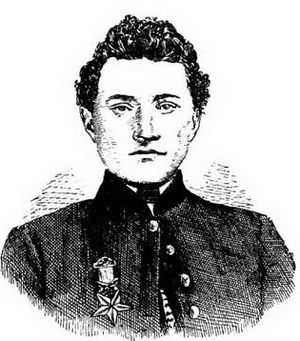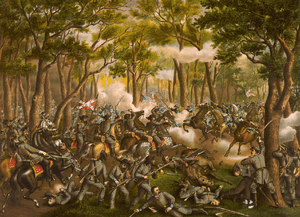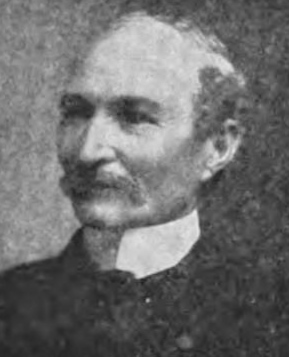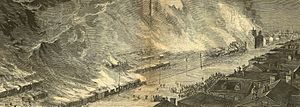Patrick H. Monaghan facts for kids
Quick facts for kids
Patrick Henry Monaghan
|
|
|---|---|

Corp. Patrick H. Monaghan, c. 1864
|
|
| Born | November 19, 1843 Belmullet, County Mayo, Ireland |
| Died | October 22, 1917 (aged 73) Girardville, Pennsylvania |
| Allegiance | |
| Service/ |
Pennsylvania National Guard, 1872–1884 U.S. Army (Union): 48th Pennsylvania Infantry, 1861–1865 |
| Rank | Lieutenant colonel (Pennsylvania National Guard) Sergeant (48th Pennsylvania Infantry) |
| Battles/wars | American Civil War
|
| Awards | |
Patrick Henry Monaghan (born November 19, 1843 – died October 22, 1917) was a brave soldier from Ireland. He fought for the United States government (the Union Army) during the American Civil War. He was part of Company F of the 48th Pennsylvania Infantry. Patrick Monaghan received the U.S. Medal of Honor, which is America's highest award for bravery. He earned it for recapturing a regimental flag on June 17, 1864, during the Siege of Petersburg in Virginia.
Contents
Early Life and Moving to America
Patrick H. Monaghan was born in Belmullet, County Mayo, Ireland, on November 19, 1843. When he was just five years old, in 1848, his family moved from Ireland to America. They settled in Schuylkill County, Pennsylvania.
Patrick went to public school in Minersville. Later, he graduated from the Normal School, which was a type of college for teachers.
Serving in the Civil War
On August 12, 1861, Patrick H. Monaghan joined the army. He was one of the first people to answer President Abraham Lincoln's call for volunteers. This call came after the fall of Fort Sumter in April 1861, which started the Civil War.
Patrick officially joined Company F of the 48th Pennsylvania Infantry as a private. He was 18 years old and worked as a laborer. Records show he was 5 feet 7 inches tall, with light hair, blue eyes, and a light skin tone.
Training and Early Battles
Patrick and his fellow soldiers in the 48th Pennsylvania learned basic infantry skills. On September 24, they traveled to Baltimore, Maryland, by train. From there, they took a steamship called the Georgia to Fortress Monroe. They continued their training there.
In November, they moved to Hatteras Island in North Carolina. They lived in wooden barracks and kept practicing their drills. In early 1862, they saw their first combat. They helped capture Roanoke Island on February 7–8, 1862.
Later, Patrick's company stayed behind while most of their regiment fought in the Battle of New Bern. They rejoined their regiment on May 23. They were then given new Enfield rifles.
Key Campaigns and Hard Fights
In June, Patrick's regiment moved back to Fortress Monroe. They were then sent to Newport News, Virginia. From there, they sailed to Aquia Creek and took a train to Fredericksburg. They supported the Union Army for about a week.
Next, they joined the Northern Virginia Campaign. They fought in the Battle of Cedar Mountain on August 9. They also took part in operations at Kelly's Ford, White Sulphur Springs, Warrenton, and Manassas Junctions. They fought against Confederate forces led by Stonewall Jackson in the Second Battle of Bull Run from August 28–30.
The fighting continued the next day, August 30. The 48th Pennsylvanians faced even tougher combat in the Battle of Chantilly on September 1. After this battle, the regiment moved to Alexandria. They were then assigned to the Maryland Campaign from September 4–20.
Patrick and the 48th Pennsylvania fought near Fox's Pass in the Battle of South Mountain on September 14. They then endured the very difficult Battle of Antietam on September 17. They engaged the enemy at Burnside's Bridge that morning. They then led their brigade in chasing Confederate troops through Sharpsburg under heavy fire. They continued to march and fight through the fall. They fought again in the Battle of Fredericksburg from December 11–15.
Moving West and Re-enlisting
In early 1863, Patrick and the 48th Pennsylvania Infantry were sent west. They traveled from Newport News to Cincinnati, passing through Baltimore, Harrisburg, and Pittsburgh. They spent a short time in Cincinnati before moving to Lexington, Kentucky.
By this time, Patrick had become a corporal. From September to December 1863, he fought with the Army of the Potomac in the East Tennessee Campaign, also known as the Knoxville Campaign. This included the Battle of Campbell's Station on November 16 and the Siege of Knoxville.
On New Year's Day in 1864, Patrick Monaghan re-enlisted with the 48th Pennsylvania in Cincinnati. He joined Company F as a sergeant and received a 30-day leave.
The Overland Campaign and Medal of Honor
Patrick returned to his regiment in February 1864. They were part of the 9th Corps and assigned to the Overland Campaign, led by Lieutenant-General Ulysses S. Grant. During the Battle of the Wilderness (May 5–7), Patrick was wounded.
The 48th Pennsylvania faced heavy fighting in the Battle of Spotsylvania Court House (May 8–21). They held their ground under intense fire and captured many prisoners. They charged the enemy multiple times, losing many soldiers. They also fought near the North Anna and Pamunkey rivers. Then, they fully engaged the enemy in the Battle of Cold Harbor (June 3–12).
It was during the Siege of Petersburg that Patrick Monaghan performed the act of bravery for which he received the U.S. Medal of Honor. On June 17, 1864, he bravely recaptured the regimental flag of the 7th New York Heavy Artillery. This was a very important act, as losing a flag was a great dishonor.
Patrick and his regiment were involved in preparing the mine for the explosion at Petersburg in June and July. However, they did not fight in the actual Battle of the Crater on July 30. They next fought in the Battle of Poplar Springs Church (September 30–October 2). They then occupied Fort Sedgwick from December 1864 to April 1, 1865.
On April 2, they participated in the Union's attack on Fort Mahone. They began occupying Petersburg on April 3. Their regiment was honorably discharged from service on July 17, 1865.
Life After the War
After returning to Pottsville, Pennsylvania, Patrick Monaghan married Bridget Derrick around 1870. She was also from County Mayo, Ireland, and had moved to America around 1849. They first lived in Minersville, and by 1880, they moved to Girardville. They had several children: William J., Mary B., Joseph P., Margaret M., Vincent, and Helen.
Patrick also continued his service by joining the National Guard of Pennsylvania. He became a captain in 1872, a major in 1879, and a lieutenant colonel in 1880. During his time in the National Guard, he helped keep peace and order. For example, his unit was called to Shenandoah in 1875 and to Pittsburgh in 1877 to help restore order during difficult times. They also provided support for the 1876 Centennial Exposition in Philadelphia.
By 1900, Patrick was a naturalized citizen of the United States. He continued to live in Girardville with his wife and children. That fall, he gave a speech at his old Civil War regiment's reunion. He also attended the reunion in 1905 and was photographed wearing his Medal of Honor at a veteran's reunion in 1913.
By 1910, Patrick still lived with his wife and all his surviving children. His sons William J. and Vincent D. had become a doctor and a pharmacist, respectively.
Death and Burial
Patrick Monaghan passed away in Girardville, Pennsylvania, on October 22, 1917. He was buried at Saint Joseph's Cemetery in Girardville.
See also
- Infantry Tactics
- Irish Americans in the American Civil War
- List of American Civil War Medal of Honor recipients: M–P
- Pennsylvania in the American Civil War




